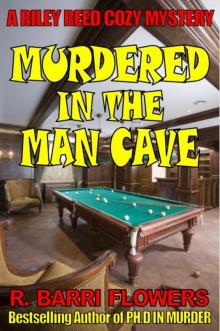- Home
- R. Barri Flowers
Terror in East Lansing: The Tale of MSU Serial Killer Donald Miller
Terror in East Lansing: The Tale of MSU Serial Killer Donald Miller Read online
TERROR IN EAST LANSING
The Tale of MSU Serial Killer Donald Miller
A True Crime Short
By R. Barri Flowers
TERROR IN EAST LANSING
The Tale of MSU Serial Killer Donald Miller
A True Crime Short
Copyright 2014 by R. Barri Flowers at Smashwords. All rights reserved.
Terror in East Lansing reprinted from Masters of True Crime: Chilling Stories of Murder and the Macabre, ed. R. Barri Flowers (Amherst, NY: Prometheus Books, 2012), pp. 15-27. Copyright 2012 by R. Barri Flowers. All rights reserved. Used with permission of the publisher; http://www.prometheusbooks.com/.
Cover Image Copyright: Szasz-Fabian Jozsef, 2014
Used under license from Shutterstock.com
Smashwords Edition, License Notes
This ebook is licensed for your personal enjoyment only. This ebook may not be re-sold or given away to other people. If you would like to share this book with another person, please purchase an additional copy for each recipient. If you're reading this book and did not purchase it, or it was not purchased for your use only, then please return to Smashwords.com and purchase your own copy. Thank you for respecting the hard work of this author.
In memory of the victims of Donald Miller and their lost potential.
And to Michigan State University's distinguished School of Criminal Justice that gave me my start as an ambitious student and award-winning criminologist, turned bestselling crime writer.
* * *
TRUE CRIME BOOKS BY R. BARRI FLOWERS
The Dynamics of Murder: Kill or Be Killed
Masters of True Crime: Chilling Stories of Murder and the Macabre (editor)
Murder Chronicles: A Collection of Chilling True Crime Tales
Murders in the United States: Crimes, Killers, and Victims of the 20th Century
Prostitution in the Digital Age: Selling Sex from the Suite to the Street
Serial Killer Couples: Bonded by Sexual Depravity, Abduction, & Murder
The Sex Slave Murders: The True Story of Serial Killers Gerald & Charlene Gallego
TRUE CRIME SHORTS
Dead at the Saddleworth Moor: The Crimes of Ian Brady & Myra Hindley
Killers of the Lonely Hearts: The Tale of Serial Killers Raymond Fernandez & Martha Beck
Mass Murder in the Sky: The Bombing of Flight 629
Murder at the Pencil Factory: The Killing of Mary Phagan 100 Years Later
Murder of a Star Quarterback: The Tragic Tale of Steve McNair & Sahel Kazemi
Murder of the Banker's Daughter: The Killing of Marion Parker
The "Gold Special" Train Robbery: Deadly Crimes of the D'Autremont Brothers
The Amityville Massacre: The DeFeo Family's Nightmare
The Pickaxe Killers: Karla Faye Tucker & Daniel Garrett
The Sex Slave Murders 2: The Chilling Story of Serial Killers Fred & Rosemary West
The Sex Slave Murders 3: The Horrific Tale of Serial Killers Leonard Lake & Charles Ng
* * *
PRAISE FOR TRUE CRIME BOOKS BY R. BARRI FLOWERS
"Selected as one of Suspense Magazine's Best of 2011 books." — John Raab, CEO/Publisher of Suspense Magazine on THE SEX SLAVE MURDERS
"Formidable combination of criminological expertise and sheer storytelling ability." — Harold Schechter, true crime historian author on MURDER CHRONICLES
"A gripping account of the murders committed by husband-and-wife serial killers Gerald and Charlene Gallego." — Gary C. King, author of Blood Lust on THE SEX SLAVE MURDERS
"R. Barri Flowers always relates an engrossing story." — Robert Scott, author of The Last Time We Saw Her on THE SEX SLAVE MURDERS
"A model of exposition not to be missed by anyone interested in the annals of American criminal behavior." — Jim Ingraham, Ph.D., professor emeritus of American Studies at Bryant University on THE PICKAXE KILLERS
"Striking, well-written tales sparkle in this ocean of murder." — Diane Fanning, author of Mommy's Little Girl on MASTERS OF TRUE CRIME
"Exhaustively researched, each storyteller brings their own unique prose to these pages, creating what will soon become a true crime classic." — Kevin M. Sullivan, author of The Bundy Murders on MASTERS OF TRUE CRIME
"This book should be a mandatory purchase and read for any true-crime buff." — Steven A. Egger, Ph.D., associate professor on MASTERS OF TRUE CRIME
"Incredible cases, psychopathic killers, unwitting victims, along with the very best writers, make for an exciting, no-holds-barred, soon-to-be true-crime classic." — Dan Zupansky, host of True Murder on MASTERS OF TRUE CRIME
"An indispensable sourcebook for anyone interested in American homicide, from law-enforcement professionals to armchair criminologists." — Harold Schechter, author of The Serial Killer Files on THE DYNAMICS OF MURDER
"Vivid case studies of murder to complement this well researched criminology text." — Scott Bonn, Ph.D., criminology professor on THE DYNAMICS OF MURDER
* * *
TABLE OF CONTENTS
Terror in East Lansing: The Tale of MSU Serial Killer Donald Miller
The Midwest Murders: Alton Coleman & Debra Denise Brown – Bonus True Crime Story
The Sex Slave Murders: The True Story of Serial Killers Gerald & Charlene Gallegos – Bonus Excerpts
The Sex Slave Murders 3: The Horrific Tale of Serial Killers Leonard Lake & Charles Ng – Bonus Excerpts
The Amityville Massacre: The DeFeo Family's Nightmare – Bonus Excerpts
About the Author
* * *
terror in east lansing
The Tale of MSU Serial Killer Donald Miller
In the latter part of the 1970s, Michigan's Big Ten school Michigan State University (MSU) in East Lansing was the place to be for higher education, athletics, sexual experimentation, keggers, smoking pot, and expressing oneself. The school had a well-deserved reputation for partying. And MSU in the 1970s also turned out to be the place and time for a brutal serial killer to emerge, one who would take aim at young women, sexually assaulting them before violently ending their lives.
Donald Miller was not just another serial killer. The twenty-four-year-old graduate of MSU's renowned School of Criminal Justice once seemed to be on track for a totally different connection with the criminal justice system. But at some point, destiny took a deadly turn, and Miller achieved the distinction of becoming East Lansing's and MSU's only known serial killer—a distinction the community would prefer to forget. But Miller left a mark that seemingly makes such a thing impossible in the halls of academia and the surrounding area.
* * *
Michigan State University's School of Criminal Justice, founded in 1935, is the country's oldest continuous program for granting degrees in criminal justice. Originally known as the School of Public Administration and Public Safety, it followed the "land-grant philosophy" established by Michigan State Agricultural College. This philosophy is derived from the Morrill Act, signed in 1862 by President Abraham Lincoln to provide a generous "grant of land to each state, the revenue of which was to be used for the development and support of agriculture schools."
Within this context, the land-grant institution became the first college in the nation to offer a bachelor of science degree in police administration, the intent being to use scientific education and training to properly prepare students for careers in law enforcement, private investigation, and in other areas of criminal justice.
By 1977, MSU's School of Criminal Justice had presented undergraduate and graduate degrees to thousa
nds of students under the direction and tutelage of such criminal justice and criminology legends as Donald Bremer, Arthur Brandstatter, Ralph Turner, Robert Scott, Louis Radelet, Zolton Ferency, Leon Weaver, Vincent Hoffman, and Robert Trojanowicz, among others.
Donald Miller was among those graduates to receive a degree in criminal justice from Michigan State. But rather than use it to pursue a career in law enforcement, government, or perhaps teaching, he took a decidedly different and dark path, turning into a psychopath, rapist, and serial killer.
* * *
Born on December 28, 1954, Donald Gene Miller was described as the "quintessential boy-next-door." Having grown up in a peaceful, middle-class area in the college town of East Lansing, Michigan during the rebellious 1970s, it would have been quite easy for him to have gotten caught up in the type of crowd among which long hair, drug use, and sowing one's oats was fairly common. Instead, by all accounts, Miller walked the straight and narrow, respected his elders, kept his hair short, and was a youth minister at the local church. He attended Michigan State University, majoring in criminal justice. It seemed like he was well on his way toward finding a successful career in law enforcement or some other impressive occupation within the world of law and order.
Adding to this picture of apparent perfection, Miller had started dating a girl from his church, Martha Sue Young, who lived down the street and was friends with Miller's older sister. By the winter of 1976, Miller, twenty-one, and nineteen-year-old Young, who also attended Michigan State, were engaged. The couple seemed to be headed toward matrimony and a good life as two bright students in love with life and each other.
But that all changed rather abruptly. Just before New Year's Eve 1976, Young called off the engagement. According to her mother, Sue Young, there were a number of reasons her daughter did not go through with the marriage, such as "the fact that Don was twenty[-two] years old and never had a job," apart from a brief stint working in a resort community the previous summer.
The two also differed in their attitudes about education. Whereas Young loved college and was serious about studying and getting good grades, Miller felt just the opposite. "Don never studies, and his grades aren't good," Martha told her mother. Sue Young noted that her daughter enjoyed athletics and socializing in college but complained that "it's not only that [Don] doesn't, but he doesn't want me to either."
Whatever the reasons, or combination thereof, for breaking off their engagement, an embittered Miller had no intention of fading into the woodwork as Young sought greener pastures. Miller was able to convince her that they should remain friends at the very least, insisting that she keep the engagement ring, with no strings attached, with regard to the promise of future romance.
Young, who may have been wary of such an offer, chose to give her ex-fiancé the benefit of the doubt and maintain the friendship. Based on Miller's clean record with the law, on their being members of the same church, and on the strong camaraderie between their families, it seemed there was no harm in giving Miller at least this much.
But Young could not read Miller's devious mind. Nor did she realize that he was anything but a safe bet—not until it was too late to change the dark destiny in store for her.
* * *
New Year's Day 1977 marked the start of the winter term at Michigan State University, with students streaming back on to the campus from Christmas break, prepared to resume their march toward fulfilling necessary requirements for degrees. Then, of course, there was catching up with old friends, making new ones, and partying—both to welcome in the New Year and simply for the sake of keeping up with campus traditions.
It was on that cold day that Martha Sue Young went missing. East Lansing police officer Kenneth Ouellette had just begun his shift when the call came in. It was from Gene Miller, Donald's father. Ouellette knew the Millers because he and Donald had sometimes gone to a local sportsman and rifle club together.
Gene Miller was calling the station at the request of Sue Young, Martha's mother. The young woman was missing after allegedly being dropped off at her home by Donald a few hours earlier, having gone out with him as friends.
Ouellette went to Young's house, initially believing there was probably nothing to worry about. "Typically, most of these things turn out to be that they stayed at a friend's house or their date's house," the officer suggested. "It's that college-town type of thing you associate with it."
But Ouellette changed his tune once he got to the house. Martha Sue Young's disappearance suddenly struck him as anything but normal. As he honed in on some of the things about her and Donald, such as that they did not drink, that neither were known to be active in the party scene, that both still lived at home, and that both attended church regularly and held religious views that were conservative, the officer grew increasingly concerned about Martha's unexplained absence.
* * *
In 1985, Michigan State University's School of Criminal Justice celebrated its fiftieth anniversary. With a rich history of producing graduates who went into fields across the criminal justice spectrum and around the world, there was reason to celebrate.
When the new program began in 1935, there were a mere twenty-three freshman and eleven sophomore and junior enrollees. By 1985, enrollment in the school had soared to six hundred undergraduate students, one hundred and fifteen students seeking master's degrees, and twenty PhD candidates.
Among the school's accomplishments was the first annual Institute on Police Community Relations in 1955 and a designation by the Law Enforcement Assistance Administration in 1973 as a national center of excellence. According to a 1979 article in the Journal of Criminal Justice, "Michigan State University ha[d] the highest known reputation among the almost 1,200 criminal justice programs in the country." Moreover, the Joint Commission of Criminology and Criminal Justice Education and Standards had consistently rated the School of Criminal Justice as one of the top two such programs in the nation.
In all, nearly six thousand students had graduated from the School of Criminal Justice in the program's first fifty years, many going on to distinguished careers in law enforcement, government, criminology, and other related fields.
* * *
A few days before Martha Young's disappearance, the coed had expressed relief that Donald Miller had seemingly accepted the end of their engagement with no hard feelings. As a result, she even agreed to attend Miller's birthday party at the home of a friend of his grandmother the following evening as previously planned, if only to keep up appearances for his family.
On Friday afternoon, New Year's Eve 1976, Young stopped by the Great Steak Restaurant in East Lansing, where her mother was having lunch with a friend, to show the two women the shoes she had purchased for a party she planned to attend on New Year's Day. It seemed as though 1977 was destined to get off to a great start for the college student.
That evening, Sue Young was in the kitchen when Martha came in to give her a kiss good-bye before leaving for what was supposed to be a fun night that she and Donald Miller were sure to enjoy.
It would be the last time Sue Young would ever see her daughter alive.
* * *
Police officer Kenneth Ouellette was worried about the missing Martha Sue Young. And there was plenty to consider when it came to her health and safety. "We started to focus in on the fact that Donald was not a drinker or a partier," Ouellette said. "Martha Sue was not a partier, they both lived at home, they both had conservative religious views, they were active in the church. As I would eliminate some of these things, the concern grew."
As a result of the officer's alarm over Martha Young's inexplicable and uncharacteristic absence, he focused his investigation on the last known person believed to have seen her alive: Donald Miller.
* * *
At midnight on January 1, 1977, Peter Houk took his place as Ingham County's new prosecuting attorney. His very first case turned out to be one of the most important and publicized of his career. It also laid the groundwork in fo
rever changing the façade of innocence and safety that had seemed a given across the beautiful campus of Michigan State and the surrounding community. A killer was on the loose and hidden in plain sight.
The spotlight was squarely on Donald Miller, whose alibi would be discredited over the coming months. Evidence indicated that Miller had not told police everywhere he had been on the day Martha Sue Young disappeared. He took two polygraph tests and failed both. The lack of emotion shown by the suspect about his ex-fiancée's disappearance gave the authorities and family members of the missing young woman further cause for suspicion.
Houk and the lead investigator, East Lansing police detective Rick Westgate, had little doubt that Martha Young was the victim of foul play and that Miller was behind it. Unfortunately, there was no solid evidence to build a case. Without such, Miller was able to remain free, which would cost other young women their lives. For the time being, there wasn't anything the authorities could do about it.
The suspect lived with his parents, who staunchly supported his innocence, much to the chagrin of the police, who were convinced otherwise. Westgate would later say, "If the parents hadn't been so stubborn and they had listened to all of the information we had regarding where he had been, if they wouldn't have blocked us, there wouldn't have been three other homicides."

_preview.jpg) Ph.D in Murder (A Cozy Mystery Short)
Ph.D in Murder (A Cozy Mystery Short)_preview.jpg) Billy The Kid’s Wife (A Time Travel Romance Short)
Billy The Kid’s Wife (A Time Travel Romance Short) Murder Aboard the Titanic: A Mystery At Sea Short
Murder Aboard the Titanic: A Mystery At Sea Short_preview.jpg) Convinced (A Women’s Suspense Short)
Convinced (A Women’s Suspense Short)_preview.jpg) Target of a Killer (A Crime Thriller Short)
Target of a Killer (A Crime Thriller Short)_preview.jpg) The Phone Call (A Psychological Mystery Short)
The Phone Call (A Psychological Mystery Short)_preview.jpg) Vandals (A Young Adult Thriller Short Story)
Vandals (A Young Adult Thriller Short Story) Quad Squad
Quad Squad_preview.jpg) The Wrong End Of A Gun (A Noir Mystery Short)
The Wrong End Of A Gun (A Noir Mystery Short) Murder of the Hula Dancers
Murder of the Hula Dancers Murder in Maui
Murder in Maui Teen Ghost at Dead Lake
Teen Ghost at Dead Lake Murdered in the Man Cave (A Riley Reed Cozy Mystery)
Murdered in the Man Cave (A Riley Reed Cozy Mystery) Terror in East Lansing: The Tale of MSU Serial Killer Donald Miller
Terror in East Lansing: The Tale of MSU Serial Killer Donald Miller The Jury Has Spoken
The Jury Has Spoken Murder on Kaanapali Beach
Murder on Kaanapali Beach Death by Trial and Error (A Legal Suspense Short)
Death by Trial and Error (A Legal Suspense Short)